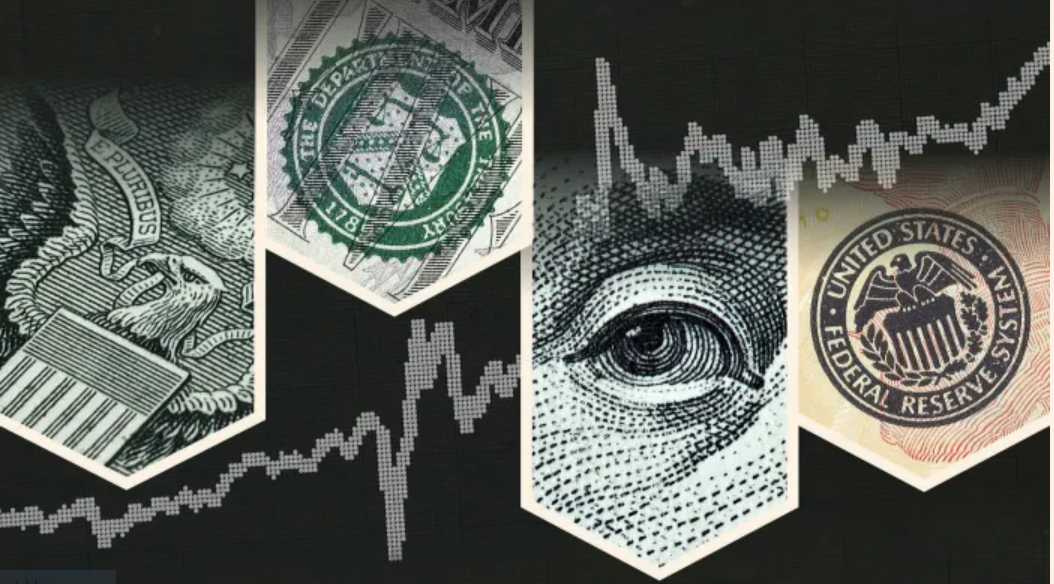Den såkaldte rentekurve er faldet i USA, dvs. at renteforskellen på korte og lange obligationer er blevet mindre. Nogle analytikere frygter, at rentekurven flader ud, og at der ikke bliver en forskel – ja, enkelte frygter, at rentekurven bliver vendt på hovedet, så renten bliver højere på de korte papirer. Det har selv chefen for verdens største formueforvalter, BlackRock, advaret om. Det kan ende i en ny recession. En analyse fra den amerikanske centralbank viser, at siden 1955 har en “omvendt” rentekurve altid ført til en efterfølgende recession – undtagen i et enkelt tilfælde. Rentekurven var også omvendt i 2019, men da blev recessionen dog udløst af pandemien. Det er en udbredt holdning i finanssektoren, at rentekurven vil flade ud i løbet af dette år. I dag er den to-årige T-bond rente steget kraftigt til 1,16 pct., mens den 10-årige T-bond er steget langt mindre til 1,8 pct.
Explainer-The U.S. yield curve has been flattening: Why you should care
The U.S. Treasury yield curve has been flattening over the last few months as the Federal Reserve prepares to hike rates, and some analysts are forecasting more extreme moves or even inversion.
The shape of the yield curve is a key metric investors watch as it impacts other asset prices, feeds through to banks’ returns and even predicts how the economy will fare. Here’s a quick primer explaining what a steep, flat or inverted yield curve means and whether it will forecast the next U.S. recession.
WHAT IS THE U.S. TREASURY YIELD CURVE?
The U.S. Treasury finances federal government budget obligations by issuing various forms of debt. The $23 trillion Treasury market includes Treasury bills with maturities from one month out to one year, notes from two years to 10 years, as well as 20-and 30-year bonds.
The yield curve plots the yield of all Treasury securities.
WHAT SHOULD THE CURVE LOOK LIKE?
Typically, the curve slopes upwards because investors expect more compensation for taking on the risk that rising inflation will lower the expected return from owning longer-dated bonds. That means a 10-year note typically yields more than a 2-year note because it has a longer duration. Yields move inversely to prices.
A steepening curve typically signals expectations of stronger economic activity, higher inflation, and higher interest rates. A flattening curve can mean the opposite: investors expect rate hikes in the near term and have lost confidence in the economy’s growth outlook.
WHY IS THE YIELD CURVE FLATTENING NOW?
Yields of short-term U.S. government debt have been rising fast this year reflecting expectations of a series of rate hikes by the U.S. Federal Reserve, while longer-dated government bond yields have moved at a slower pace amid concerns that policy tightening may hurt the economy.
As a result, the shape of the Treasury yield curve has been generally flattening. A closely watched part of the curve, measuring the spread between yields on two- and 10-year Treasury notes, shows the gap at roughly 60 basis points, nearly 20 points lower than where it ended 2021. That flattening steadied this week as investors viewed some Fed officials as being a bit less hawkish.
While rate increases can be a weapon against inflation, they can also slow economic growth by increasing the cost of borrowing for everything from mortgages to car loans.
Two-year U.S. Treasury yields, which track short-term interest-rate expectations, have risen to 1.16% from 0.73% at the end of last year – a 60% increase.
U.S. benchmark 10-year yields have gone up to about 1.8% from 1.5%, a 20% rise.
WHAT DOES AN INVERTED CURVE MEAN, AND WILL IT HAPPEN?
Some investors and strategists are starting to forecast a curve inversion could happen as soon as this year – an ominous sign.
The U.S. curve has inverted before each recession since 1955, with a recession following between six and 24 months later, according to a 2018 report by researchers at the Federal Reserve Bank of San Francisco. It offered a false signal just once in that time.
The last time the yield curve inverted was in 2019. The following year the United States entered a recession – albeit one caused by the global pandemic.
Strategists at Standard Chartered bank (SCBFF) forecast the curve to be completely flat by mid-year and potentially invert by year-end.
Larry Fink, the chief executive of BlackRock (BLK), the world’s biggest asset manager, has also warned about a possible curve inversion.
DOES THE WHOLE CURVE INVERT OR PARTS OF IT?
Traders typically watch the shape of the curve determined by comparing two-year and 10-year Treasury notes, because a yield curve inversion on that spread has anticipated previous recessions. That is currently flattening but not yet close to inversion.
But distortions can occur anywhere along the curve without inverting the entire curve.
On Friday, a less closely watched part of the curve inverted intraday, with the premium of U.S. Treasury 10-year notes over seven-year Treasuries going briefly into negative territory.
The 20-year/30-year spread has been negative since late October, though supply and demand technical factors may have contributed to that.
WHAT DOES THIS MEAN FOR THE REAL WORLD?
Aside from signals it may flash on the economy, the shape of the yield curve has ramifications for consumers and business.
When short-term rates increase, U.S. banks tend to raise their benchmark rates for a wide range of consumer and commercial loans, including small business loans and credit cards, making borrowing more expensive for consumers. Mortgage rates also rise.
When the yield curve steepens, banks are able to borrow money at lower interest rates and lend at higher interest rates. Conversely, when the curve is flatter they find their margins squeezed, which may deter lending.



